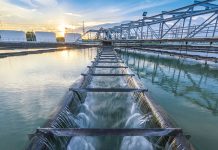“Water is not a commercial product like any other but, rather a heritage that must be protected.”
Increasing levels of European legislation, led by the Water Framework Directive, is putting great pressure on companies involved with wastewater treatment.
Nutrient removal and reduction technologies will continue to be at the centre of efforts on water protection. The presence of nutrients, especially nitrogen and phosphorous in wastewater effluents and their impacts on natural water bodies, continue to be a major concern for companies involved with wastewater treatment.
Phosphates, like nitrates, are responsible for eutrophication, causing a deterioration of an aquatic ecosystem by the proliferation of certain plants, including algae. Industrial emissions, but also urban waste streams, contain these pollutants.
Eutrophication – keeping the industry awake at night
The presence of phosphorous in rivers and lakes is responsible for eutrophication, resulting in the uncontrolled proliferation of algae and excessive consumption of dissolved oxygen in the body of the water. It is thereby less available for other living species, and in particular fish, making it necessary to restrict phosphorous discharges into natural water courses.
Conventional biological treatment processes remove only 50% or less of the sewage phosphate and substantial improvement is needed to achieve 90% or more removal to reach effluent concentrations of 0.5 to 1.0 mg phosphate per litre.
Various methods of separating phosphate from aqueous solutions exist. The physico-chemical processes utilised are based on precipitation phenomena by use of salts of calcium, iron or aluminium, or adsorption phenomena. Phosphate removal may also be achieved by biological processes.
Strategies
The removal of Phosphorous can take place successfully through a process called enhanced biological phosphorous removal. Specific bacteria are selectively enriched and accumulate large quantities of phosphorous within their cells (up to 20% of the mass). When the biomass enriched in these bacteria is separated from the treated water, these biosolids have a high fertiliser value.
A well-buffered system maintains the pH where biological activity is optimised and allows for a more efficient use of oxygen, leading to reduced energy costs. Treating wastewaters using lime-based reagents increases the wastewaters’ buffering capacity and helps the phosphorous removal step.
Phosphate precipitation
Chemical precipitation is used to remove inorganic forms of phosphate by the addition of a coagulant and a mixing of wastewater and coagulant. The multivalent ions most commonly used are calcium, aluminium and iron.
Calcium
Calcium is usually added to the process as hydrated lime Ca(OH)2. It is reported that addition of lime makes it possible to remove 85-90% of the inorganic orthophosphates present in wastewater.
The formation of calcium phosphate salts in aqueous solutions takes place following the development of supersaturation, with excess calcium ions reacting with the phosphate to precipitate hydroxyapatite.
Aluminium and Iron
Alum is widely used precipitating phosphates, as are ferric chloride and sulfate. For both reagents however, the resulting AlPO4 precipitates need to be removed by flocculation via the excess addition of a metal hydroxide, and typically lime is added to enhance this treatment step
Neutralac SLS45 Solution
The well-practised use of lime is covered in literature, coming out on top in tests looking at the efficacy of chemical precipitation with calcium hydroxide, coagulation and flocculation with aluminium sulfate as well as adsorption methods for the removal of phosphates.
In practical terms however, traditional powdered hydrated lime is best converted into a slurry prior to dosing into a wastewater.
Case Study
Phosphate removal from wastewater in the stainless steel finishing industry
Rimex Metals Group, based in Enfield, is a specialist in metal finishing and architectural metals, producing surface finishes on stainless steel and other metals. The company has manufacturing abilities throughout the world and a global distribution network.
The company traditionally used low solids content lime suspension to treat effluent which is collected in two separate sumps – one for chromic acid-based, and the other for phosphoric/sulphuric based effluent.
All the effluent is dosed with an aluminium reagent before being neutralised with a strong liquid lime (Neutralac SLS45). This is a two-step process, with the final pH around 11.5, found to be the optimum pH for the formation of calcium aluminium sulphate oxide.
The effluent containing the calcium, aluminium and sulphate ions, is then passed through an ultrasonic reactor. The reaction chemistry and kinetics are altered so that sodium oxide is formed, resulting in a very fine precipitate.
Epofloc L1-R is then dosed to ensure heavy metals removal but it also starts the flocculation process. The effluent is them pumped to a lamella settler for separation of solids and liquids. Phosphate is finally removed by precipitation with aluminium and calcium.
Key Achievements
The use of Neutralac® SLS45 had positive effects in the wastewater treatment procedure. Neutralac® SLS45 has proved to be easy to handle, simple to pump and dose. Depending on dosage rates, Rimex has been able to:
1. Achieve removals of up to 99.9% for phosphates, and up to 99.7% for sulfates and heavy metals
2. Reduce its reagent costs by up to 20%
3. Reduce the operators’ workload considerably due to the lower number of delivery vehicles required.





